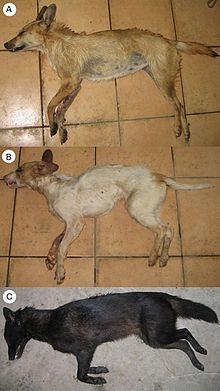Jackal-wolf hybrid
| Jackal–dog hybrid | |
|---|---|
 |
|
| Three hybrids between golden jackals and domestic dogs legally shot in Croatia | |
|
Not evaluated (IUCN 3.1)
|
|
| Scientific classification | |
| Kingdom: | Animalia |
| Phylum: | Chordata |
| Class: | Mammalia |
| Order: | Carnivora |
| Family: | Canidae |
| Genus: | Canis |
| Species: | C. lupus x C. aureus |
A jackal–dog hybrid is a canid hybrid resulting from a mating between a dog and a golden jackal. Such crossbreeding has occurred numerous times in captivity, and was first confirmed to occasionally happen in the wild in Croatia in 2015.
Similar matings between golden jackals and grey wolves have never been observed, though evidence of such occurrences was discovered through mtDNA analysis on jackals in Bulgaria. Although there is no genetic evidence of grey wolf-jackal hybridization in the Caucasus Mountains, there have been cases where otherwise genetically pure golden jackals have displayed remarkably grey wolf-like phenotypes, to the point of being mistaken for wolves by trained biologists.
Scottish surgeon and amateur naturalist John Hunter was the first to write an account of the two species' interfertility in 1787. He described how a ship captain of the East India Company adopted a female jackal and had it mated to his spaniel, after which it whelped six pups upon arriving in England. Hunter purchased one of the female hybrid pups and attempted to mate it with several dogs upon reaching maturity. Further crossbreeding experiments were initially hampered by the hybrid female's apparent disinterest in the dogs brought to it, though it subsequently mated with a terrier and produced five pups.
Marie Jean Pierre Flourens attempted his own crossbreeding experiments nearly a century later, noting that first-generation matings between the two species tended to produce animals in which jackal characteristics were dominant, having straight ears, hanging tails, lack of barking, and wild temperaments. A similar observation was made by Robert Armitage Sterndale, who recorded a jackal-dog crossbreeding experiment spanning several generations in British India, noting that glaring jackal traits could be exhibited in hybrids even after three generations of crossing them with dogs. Flourens, however, observed that his jackal hybrids became sterile after the fourth generation, but could be mated back to either parent species.
...
Wikipedia
